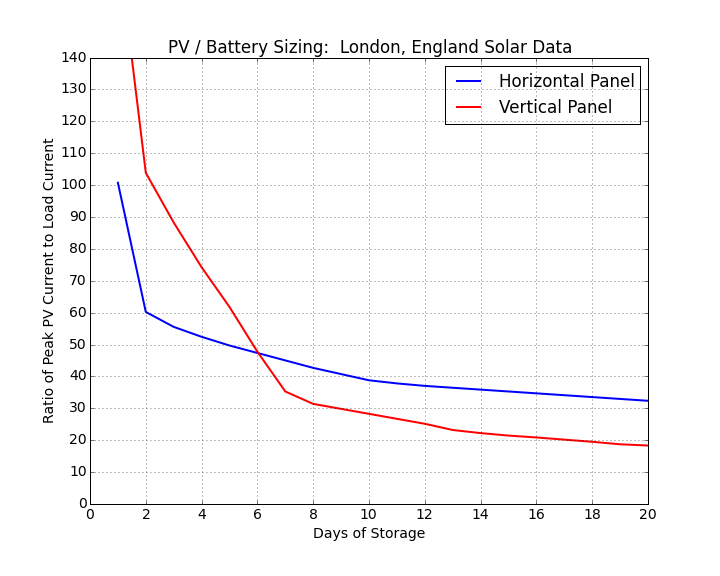I did some modeling of storage and PV requirements for a pyboard drawing a particular amount of average current. It sounds like you're not certain what that average current draw is, so I expressed results in a way that can be applied to any level of average current draw. The needed PV and storage are linear with the current draw--if you double the load, you'll double the needed PV/storage combination.
Our US Renewable Energy Lab has a simple yet respected tool for modeling PV systems called
PVWatts. It turns out, they have solar data for London, so that is what I used. The tool is meant to model home-scale grid-tied PV systems, not tiny panels connected to a Pyboard. But, the tool does let you export hourly solar output for any orientation. I exported that hourly data for both a horizontal panel and a vertical panel facing south in London England. I used the hourly data in an iPython notebook model that determines how well a particular combination of PV and storage serves a load. I used that model to develop the following plot, which hopefully can help you size your mini solar system.

The horizontal axis indicates how much battery storage you have. It is expressed in terms of days of storage; if you have 2 days of storage, that means your battery could supply the Pyboard load for 2 days without any solar recharge. The vertical axis is the size of the solar panel you will need to ensure that the system works for every hour of the year; i.e., the battery never discharges fully. The units of the vertical axis are the PV panel maximum Amps divided by the Load Amps. So, if the graph value is 50, and your load is 12 mA, you need a panel with a peak rating of 12 mA * 50 = 600 mA.
If you have a small battery, say enough to make it through one day, you need a big panel because you have to size the panel for the absolute worst day of the year--a rainy December day. If you have a lot of storage, you can ride those really bad days out with solar stored up from prior better days. The graph shows that there are large benefit to storage up to about 6-8 days of storage; diminishing returns occur after that level.
Here is an example. You will probably get your average load very low by sleeping at very low current for a large percentage of your operating time. But, I'll do an example at a much higher average current, say 10 mA. Say you decide on 6 days of storage. That means that you need 10 mA * 24 hrs/day * 6 days =
1,440 mAh of
useable storage (temperature and the 3.6 V Pyboard limit will affect the useable storage of a LiPo battery). It just happens that the needed panel size is the same for horizontal or vertical orientation at that level of storage. You need about 48 times your load current in PV panel, so you need a panel with rating in peak sunlight of 10 mA * 48 =
480 mA. There is
no safety margin built into this. PVWatts builds in 3% loss due to shading, but particularly if your panel is vertical, it's very easy to get shaded in the winter when sun angles are low. A horizontal panel during the critical winter period is getting most of its solar as diffuse radiation from the entire sky, so shading issues are not as critical. Adafruit has a 530 mA panel and a 930 mA panel. If your panel is horizontal AND you dont' think it will get covered with snow or a leaf, *maybe* the 530 mA would work. Unless the view to the south were wide open, I'd go with the 930 mA panel for a vertical panel, but at least you don't have to worry about snow (I'm in Alaska; we worry about snow!).
I should note that my calculation model assumes an Adafruit type control board where 1 mAh from the panel puts 1 mAh into the battery and 1 mAh delivered to the load. These calcs don't apply to MPPT chargers or solar charger boards like the SEEED that convert the battery voltage to a higher load voltage.
The other issue is how large of a LiPo battery do you need to provide 1,440 mAh of effective storage. At room temperature and the very low discharge rate imposed by the Pyboard load, you can get 90% of the rated mAh out of the battery before it's voltage drops down to 3.6 V, the Pyboard limit. But, I suspect all your equipment is outside. From my quick Googling, it looks like you only get about 40% of the rated battery capacity at 0 deg C if your usable cutoff voltage is 3.6 V. So, that means that if you need 1,440 mAh of effective storage, you need to use a battery rated at 2.5 x that value, or 1440 mAh * 2.5 =
3,600 mAh. Adafruit sells 4,400 mAh and a 6,600 mAh units. 18650 cells have 2,500 - 3,400 mAh depending on model, so one or two in parallel would suffice and be relatively inexpensive.
There are logical explanations for why the Vertical orientation and Horizontal Orientatiin lines cross on the graph, but I fear I've carried on too long already. I'm quite interested in the topic, so if you have any questions please ask.
